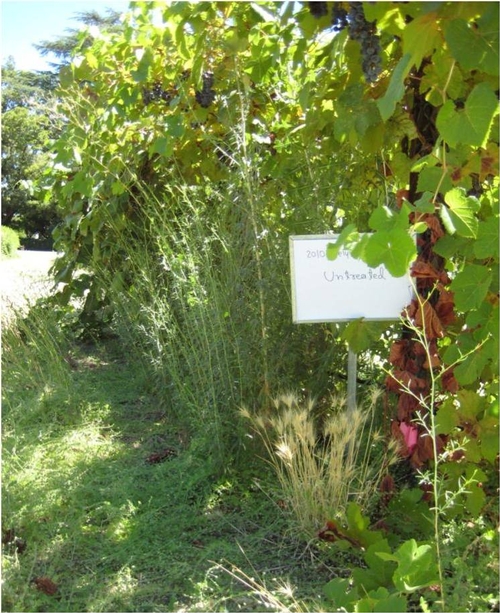Today I thought I would post a brief writeup and a poster presentation by Amit Jhala, a recent postdoctoral researcher in the UCD weed group. Amit and I put out two small experiments in the spring of 2010 to evaluate combinations of glyphosate (Roundup WeatherMax) plus various residual herbicides in a walnut orchard near Davis and a vineyard near Winters, CA.
All treatments included 2 lb ae/A glyphosate The residual materials included:
- penoxsulam (to be registered alone as "Tangent" and is one of the active ingredients in "Pindar GT")
- indazaflam (to be registered as "Alion")
- flumioxazin (registered as "Chateau") and
- rimsulfuron (registered as "Matrix", "Mana" and others).
In these experiments there were relatively few statistical differences in performance among the residual herbicides. However, at the grape site which was dominated by panicle willowherb, lowest weed biomass tended to be in plots treated with flumioxazin and penoxsulam. At the walnut site, dominated by bermudagrass and field bindweed the high rate of indazaflam plus glyphosate provided the greatest weed supression but still not acceptable control.
There were several issues with the experiments that must be noted. First, the application timing was several months later than a more realistic "dormant season" application. Second, all treatments included a very high rate of glyphosate (2 lb ae is roughly 56 fl oz/A of Roundup WeatherMax) which likely masked some of the effects of the residual materials.
In spite of thse problems, the trial gave me a first look in 2010 at several of these herbicides which are labeled or nearing registration in orchards and vineyards. This season, we have established several new trials in almond, walnut, and grapes to test these herbicides on more weed species including glyphosate-resistant populations. Penoxsulam and indazaflam, in addition to the currently-available rimsulfuron and flumioxazin, should provide vine and orchard growers new opportunities for weed control and herbicide resistance management.
Brad

Summer weed control with glyphosate tank mixed with indaziflam or penoxsulam in California orchards and vineyards.
Amit J. Jhala and Brad D. Hanson*, Department of Plant Sciences, University of California, Davis, CA, 95616.
Herbicides are an important component of weed control in perennial, high value crops including walnut and grape in California. If not controlled, weeds may aggravate pest problems and compete with trees for nutrients and water. Indaziflam (submitted for registration) and penoxsulam are new herbicides for weed control in perennial fruit, nut and vine crops. Field experiments were conducted to evaluate residual weed control with indaziflam or penoxsulam compared with flumioxazin and rimsulfuron in established walnut and grapes in Yolo County, CA. At both the sites, treatments included glyphosate alone (2 lb ae/acre) and glyphosate tank mixed with penoxsulam (0.015 or 0.03 lb/acre), indaziflam (0.065 or 0.085 lb/acre), flumioxazin (0.255 or 0.383 lb/acre) or rimsulfuron (0.063 lb/acre). An untreated control was included for comparison. Visual ratings of weeds were taken several times during the season. Data on weed biomass were collected on 6 Aug. and 16 July, 2010 in the walnut and grape trials, respectively.
All treatments resulted in greater than 85% control of filaree (Erodium spp.), California burclover (Medicago polymorpha), sowthistle (Sonchus spp.), and field bindweed (Convolvulus arvensis) 2.5 weeks after treatment (WAT) in the walnut trial. At this site, little mallow (Malva parviflora) control was less effective with glyphosate applied alone compared to all other treatments at 2.5 WAT, however no difference was observed among treatments at 7.5 WAT. Control of bermudagrass (Cynodon dactylon) was only 26% and 45%, respectively in glyphosate applied alone or tank mixed with flumioxazin compared to other treatments at 15.5 WAT. Total weed biomass was significantly reduced in all treatments compared to untreated plots with some difference among treatments. For example, higher weed biomass was recorded in glyphosate applied alone or in a tank mix with indaziflam at 0.065 lb/acre or flumioxazin compared to other tank mix treatments.
In the vineyard trial, there was few weed control differences among residual herbicides tank mixed with glyphosate although by early summer, most were slightly better than glyphosate applied alone. For example, panicle willowherb (Epilobium ciliatum) control 2 WAT was poor in all treatments (< 32%), except glyphosate tank mixed with flumioxazin; however, later in the season (20 WAT) willowherb control was better with a tank mix of glyphosate plus penoxsulam at 0.03 lb/acre, flumioxazin or rimsulfuron compared to other treatments. All the treatments reduced weed biomass compared to untreated plots (150 g m-2) in the vineyard trial with no differences among tank mix partners. Herbicides were applied about two months later than the recommended time; therefore it is likely that earlier applications would have improved weed control. Panicle willowherb is not well controlled with glyphosate and additional research is needed on pre- and post-emergence options for this weed in California orchards and vineyards.
Attached Files: